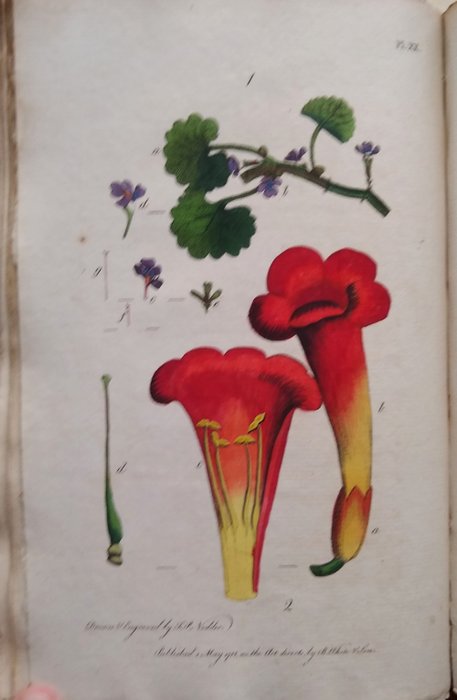
Julio Verne - Viagens Maravilhosas - 1886-1898
N.º 81821047

N.º 81821047

Thirty-eight Plates, with Explanations; intended to illustrate Linnaeus's System of Vegetables, and particularly adapted to the "Letters of the Elements of Botany". 1788. First edition.
Octavo, pp vi, 72, with 38 hand-coloured plates by Frederick Nodder, a little dull and age-toned, occasional slight blemishes, pages un-trimmed, original marbled boards rather worn but quite firm, re-backed with a later card spine and hand written paper label. An unsophisticated copy, but quite acceptable.
Blanche Henrey 1030
Letters on the Elements of Botany, addressed to a lady, by the celebrated J.J. Rousseau. Translated into English, with notes, and twenty-four additional letters, fully explaining the system of Linnaeus. The Sixth edition, with corrections and improvements. 1802.
Small thick octavo, pp xxiv, 503, (i), [26], with one folding chart in good condition, generally the pages are age-toned with some foxing, marbled edges, contemporary tree calf, the upper cover and front endpaper are both completely detached, the rest of the pages and binding are tight and firm.
Blanche Henrey 1286, who comments that in fact only eight of the letters are by Rousseau, the remaining ones being the work of Martyn.
With the Lavington coat-of-arms bookplate, and the book-label of “Wilberforce
Library / Backsettown”, which are the marks of ownership of the pioneering woman doctor
and suffragette Octavia Wilberforce (1888-1963) when living at Backsettown House, a residence in Sussex which was owned by Elizabeth Robins (1862-1952). Robins was a fellow suffragette, as well as an actor, novelist, and playwright. Wilberforce was born at Lavington House, Petworth, Sussex, and was the great-granddaughter of the famous anti-slavery campaigner William Wilberforce (1759-1833).
Her parents, not approving of her desire to become a doctor, disowned her. She
qualified nonetheless as a doctor in 1920, having trained at the London School of Medicine
for Women. Octavia Wilberforce and Elizabeth Robins, with the help of their colleague
Louisa Martindale, set up Backsettown as “a convalescent home for working women in the
country town of Backsettown, near Brighton, that was designed to educate its patients in
fitness, diet, coping with stress, and other health practices”. Both Wilberforce and Robins came to know Leonard and Virginia Woolf, who lived nearby in Sussex. In fact Wilberforce “treated Virginia
Woolf's mental illness, near the end of Woolf's life”, and it was on the 27th of March in 1941 that “Leonard drove Virginia to consult Wilberforce in Brighton; she advised complete rest, on the basis of a physical examination”, but “Virginia Woolf committed suicide the following day”.
Cómo comprar en Catawiki
1. Descubre algo especial
2. Haz la puja más alta
3. Paga de manera segura